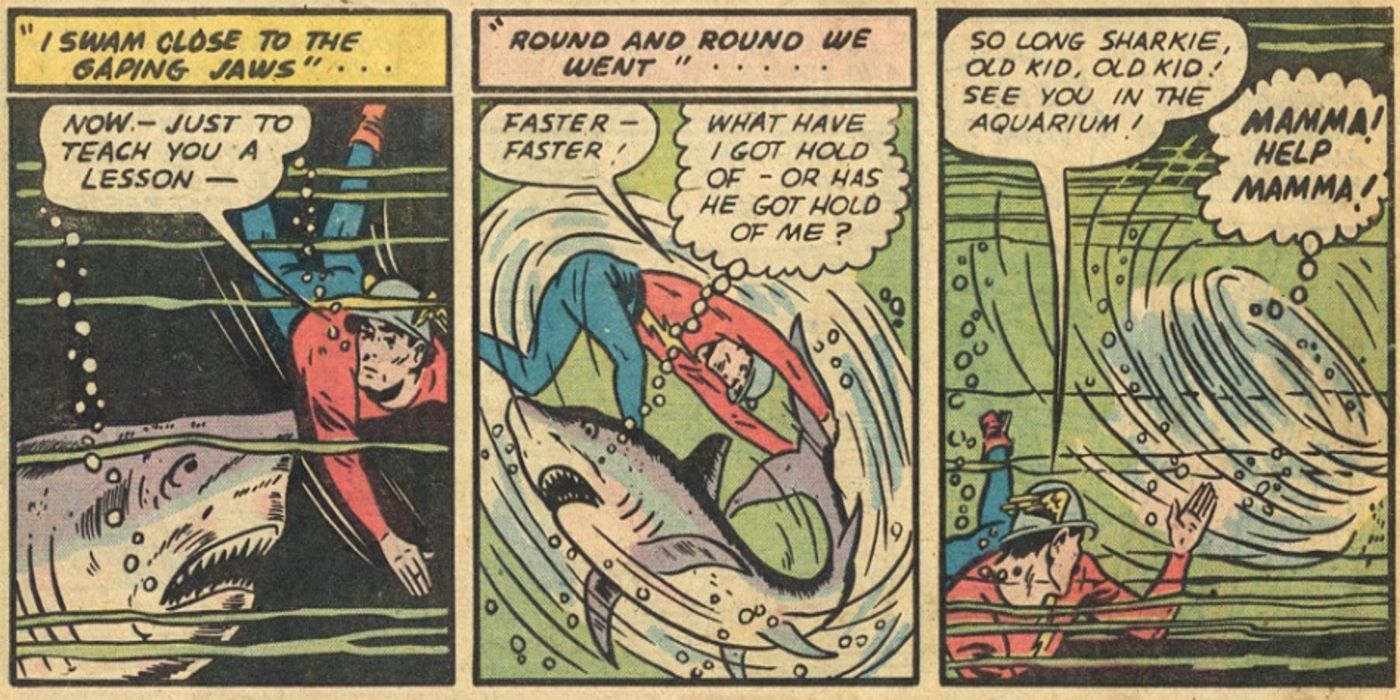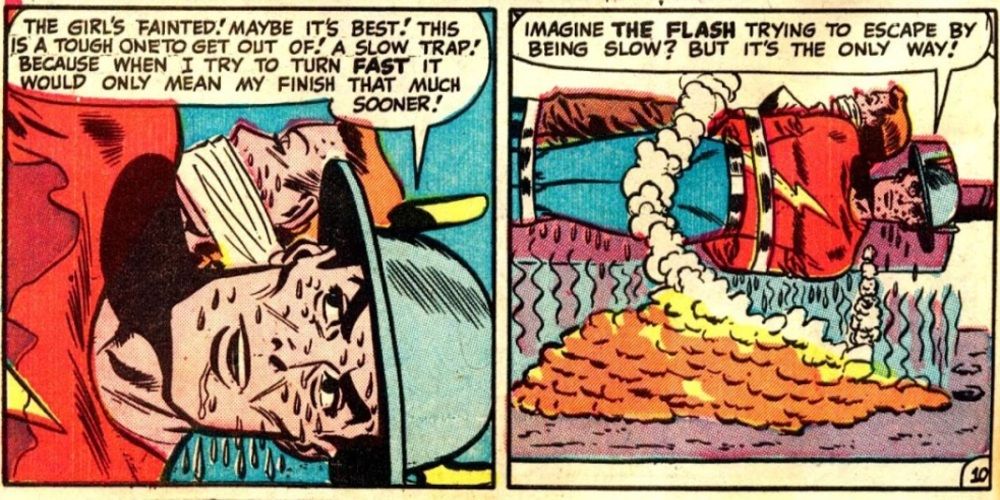Jay Garrick may not be the most famous incarnation of the Flash. But as the first character to bear the mantle, Garrick is an important figure in DC Comics history. Garrick is arguably the most enduring character – outside of DC’s trinity of Batman, Superman and Wonder Woman – to debut in comics’ Golden Age.
With his trademark cap, the wings of Mercury and the working-man simplicity of his costume, Jay Garrick is a founding member of the Justice Society and an integral part of DC’s history. Although his early tales lack the epic, sci-fi, universe-jumping of his red-suited successors, several of the comics starring the Golden Age Flash withstand the test of time.
10 Flash Comics #1
Written by comic legend Gardner Fox with art by Harry Lampert, Flash Comics #1 tells the origin of DC’s first speedster. Jay Garrick is a college student working in the laboratory when he inhales hard water fumes, putting him in a coma for two weeks. When he awakens, Garrick discovers that he can think and move at superhuman speeds.
He uses his power to help rescue Major Allen – the father of his girlfriend, Joan – from the Faultless Four, a group of criminal scientists developing an atomic weapon for a foreign government (a sometimes unpleasant reality of many Golden Age comics). It’s a standard origin story, but it was a dynamic debut for Jay Garrick as the Flash.
9 Flash Comics #104
Evil doubles have long been a staple of comics, and they are best typified in the DCU by the more modern enmity between the Flash and the Reverse-Flash. But the Golden Age Flash also encountered something of a doppelganger in the Flash Comics #104 story, “The Rival Flash!” written by John Broome and penciled by Carmine Infantino.
A criminal manages to usurp the Flash’s powers while subjecting Flash himself to “slow-down gas,” which relieves Garrick of his powers. It established a trope of the larger Flash universe in the form of an evil Flash. This 1949 story is also notable as the final Flash story of the Golden Age. Ten years later, Infantino would return to the Flash with the Silver Age reboot in Showcase #4.
8 All-Flash #14
Such was Jay Garrick’s popularity as its height that National Publications (now DC Comics) released a second Flash title. All-Flash was released quarterly, and a story from its fourteenth issue, “The Man Who Unleashed the Past” (written by Fox with art by Everett E. Hibbard) brought the character back to his science fiction roots.
After getting out of prison, the Thinker – one of DC’s smartest villains – unfurls his revenge plot against the Flash. He uses a dash of 1940s-era mad science to pull dinosaurs into the present day to battle the Speedster. It’s only with the help of a hapless trio of slapstick thugs and the impish spirit Murphy that Flash is able to defeat the monsters and the Thinker.
7 Flash Comics #86
Keeping with the prehistoric theme, “Stone Age Menace” by writer Robert Kanigher and artists Lee Elias and Joe Kubert from Flash Comics #86 again sees the original Speedster taking on dinosaurs. However, this time there’s a clever twist.
Jay and Joan observe the site of a meteor crash when they’re attacked by a T-Rex. The Flash investigates only to find he and Joan are actually in an elaborate illusion. It turns out that a museum professor had been selling priceless meteor fragments and other historical items and replacing them with fakes, setting a robotic dinosaur on Jay and Joan to keep them off his trail.
6 All-Star Comics #3
In addition to featuring the first appearance of the Justice Society of America, All-Star Comics #3 features a solo Flash story. “Wreck of the Sancta Joanna” by Fox and Hibbard sees the Flash help the treasure-hunting captain of the Sancta Joanna fend off pirates.
No matter the era, the Flash has always used his powers in inventive ways. In this tale, Garrick dispatches with a shark by creating a whirlpool and uses his super speed to turn himself into a propeller to send the pirate ship off-course. The best Flash stories put the resourcefulness of the Fastest Man Alive on display, and this issue is no exception.
5 All-Flash #20
With rare exception, the Golden Age of DC Comics didn’t often traffic in stories about extra-terrestrials. But “The Telltale Telescope” from All-Flash #20 by Fox and Martin Naydel showed the Flash on adventure on the surface of Mars. But the issue has a twist for DC readers.
The Nitwits – Winky, Blinky and Noddy – find themselves seemingly transported to a Martian landscape. As he always did, Jay has to bail them out, battling a giant robot in the process. In the end, it turns out the Nitwits stumbled onto a scheme to swindle a wealthy astronomer and hobbyist out of his fortune.
4 Flash Comics #12
War was on America’s mind in 1940, with tensions in Europe brewing between the continent’s major powers having been raging for years. In Flash Comics #12 by Fox and Hibbard, the Flash manages to end a war between rival countries in just a few pages.
In “Trouble In Kurtavia,” the Flash aids the titular fictional nation, which has been invaded by neighboring Nural. Not only does Jay Garrick defeat the entire military of the invading Nural, he does so without taking a single life. The tale might oversimplify the concept of war, but it makes fun and extensive use of the Flash’s unique abilities.
3 Flash Comics #101
Another staple of Flash stories is time travel, and the Golden Age version of the Scarlet Speedster was no stranger to this trope. In Flash Comics #101, by Broome and Infantino, Flash and his teenage friends Sue and Ted take a trip 1,000 years into the future, to the year 2949.
By vibrating at light speed, Flash and friends arrive in a museum of the future. The flying curators inform the group that Earth is split into two factions. Before heading back to the present, Flash helps reunite the world. It’s another simplistic tale but one that foreshadows the sci-fi-heavy stories that would follow in the subsequent Silver Age.
2 All-Flash #28
Secret identities are a hallmark of all superhero comics, but Jay Garrick rarely had difficulty balancing his double life. That changed in All-Flash #28’s “The Disappearing Diamonds.” Garrick is framed for stealing thousands of dollars’ worth of diamonds. Already on the run, it’s up to the Flash to clear his alter-ego’s name.
The story by Kanigher and Naydel is pure pulp nonsense, but the Flash being on the run from the police and Keystone City’s criminal element was a novel direction to take the character in. Heroes having to clear their true identities names (or vice versa) is a trope that continues to live on in the medium.
1 Comic Cavalcade #24
Just like the Golden Age Flash helped established the trope of the villainous doppelganger, it also established the idea of a hero’s polar opposite being their greatest enemy. Who would prove a better foil for the Fastest Man Alive than the world’s slowest criminal?
In “The Slow-Motion Crimes” by Kanagher and Infantino, the Flash is put to his greatest test against the Turtle, a villain whose methodical, almost plodding pace absolutely confounds the Flash. It’s a story that made use of good chemistry between opposites as well as classic, pulp death traps to hook readers from start to finish.










